Input interpretation

1, 2-dimethoxyethane
Chemical names and formulas
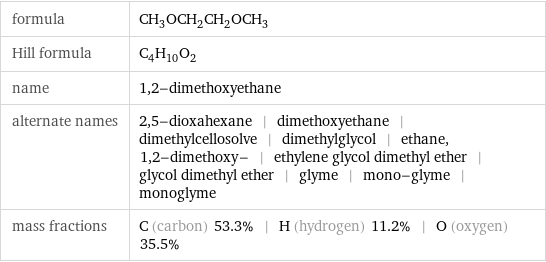
formula | CH_3OCH_2CH_2OCH_3 Hill formula | C_4H_10O_2 name | 1, 2-dimethoxyethane alternate names | 2, 5-dioxahexane | dimethoxyethane | dimethylcellosolve | dimethylglycol | ethane, 1, 2-dimethoxy- | ethylene glycol dimethyl ether | glycol dimethyl ether | glyme | mono-glyme | monoglyme mass fractions | C (carbon) 53.3% | H (hydrogen) 11.2% | O (oxygen) 35.5%
Lewis structure

Draw the Lewis structure of 1, 2-dimethoxyethane. Start by drawing the overall structure of the molecule: Count the total valence electrons of the carbon (n_C, val = 4), hydrogen (n_H, val = 1), and oxygen (n_O, val = 6) atoms: 4 n_C, val + 10 n_H, val + 2 n_O, val = 38 Calculate the number of electrons needed to completely fill the valence shells for carbon (n_C, full = 8), hydrogen (n_H, full = 2), and oxygen (n_O, full = 8): 4 n_C, full + 10 n_H, full + 2 n_O, full = 68 Subtracting these two numbers shows that 68 - 38 = 30 bonding electrons are needed. Each bond has two electrons, so the above diagram has all the necessary bonds. There are 15 bonds and hence 30 bonding electrons in the diagram. Lastly, fill in the remaining unbonded electrons on each atom. In total, there remain 38 - 30 = 8 electrons left to draw: Answer: | |
3D structure

3D structure
Basic properties
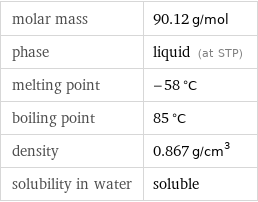
molar mass | 90.12 g/mol phase | liquid (at STP) melting point | -58 °C boiling point | 85 °C density | 0.867 g/cm^3 solubility in water | soluble
Units

Hydrophobicity and permeability properties

experimental LogP hydrophobicity | -0.21 predicted LogP hydrophobicity | 0.03 predicted LogS | 0.3
Basic drug properties

approval status | experimental | small molecule
Liquid properties (at STP)
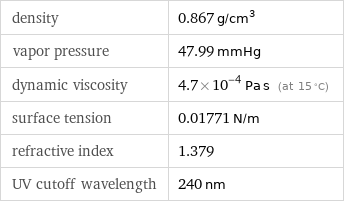
density | 0.867 g/cm^3 vapor pressure | 47.99 mmHg dynamic viscosity | 4.7×10^-4 Pa s (at 15 °C) surface tension | 0.01771 N/m refractive index | 1.379 UV cutoff wavelength | 240 nm
Units
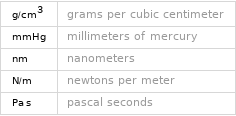
Thermodynamic properties
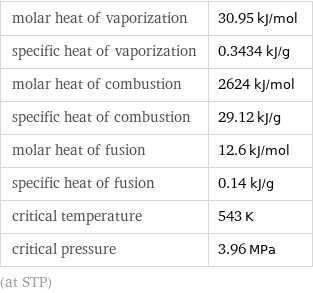
molar heat of vaporization | 30.95 kJ/mol specific heat of vaporization | 0.3434 kJ/g molar heat of combustion | 2624 kJ/mol specific heat of combustion | 29.12 kJ/g molar heat of fusion | 12.6 kJ/mol specific heat of fusion | 0.14 kJ/g critical temperature | 543 K critical pressure | 3.96 MPa (at STP)
Chemical identifiers
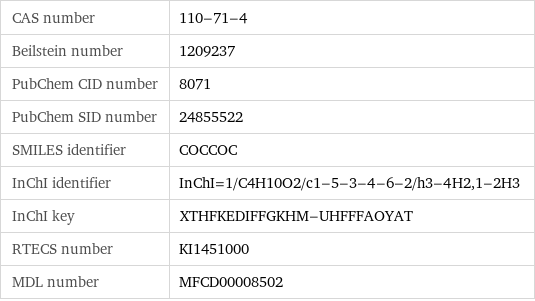
CAS number | 110-71-4 Beilstein number | 1209237 PubChem CID number | 8071 PubChem SID number | 24855522 SMILES identifier | COCCOC InChI identifier | InChI=1/C4H10O2/c1-5-3-4-6-2/h3-4H2, 1-2H3 InChI key | XTHFKEDIFFGKHM-UHFFFAOYAT RTECS number | KI1451000 MDL number | MFCD00008502
NFPA label

NFPA label
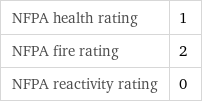
NFPA health rating | 1 NFPA fire rating | 2 NFPA reactivity rating | 0
Safety properties
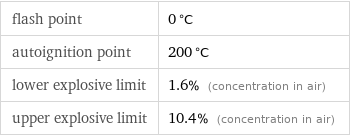
flash point | 0 °C autoignition point | 200 °C lower explosive limit | 1.6% (concentration in air) upper explosive limit | 10.4% (concentration in air)

DOT hazard class | 3 DOT numbers | 2252
Toxicity properties

RTECS classes | reproductive effector